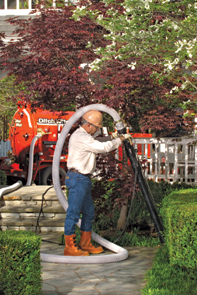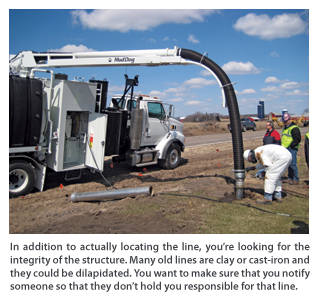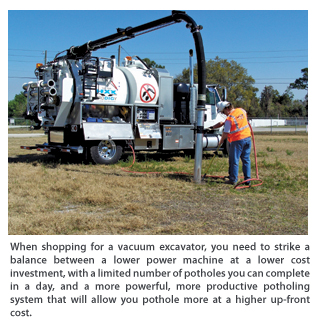Underground Utility Cartography
 The excavator’s reign over the utility construction jobsite is undisputed. But before the excavator can dig its bucket teeth into the trenches, you have to know what utility lines are already hidden below the soil’s surface. While One-Call and utility company locates are a good start, they aren’t perfect. Many One-Call and utility companies are allowed to be 18 to 24 in. off the mark, says Richard Levings, Product Marketing Manager for Ditch Witch. It’s better to be safe than sorry, and nothing is safer than doing your own locate and unearthing the existing utility using a vacuum excavator system.
The excavator’s reign over the utility construction jobsite is undisputed. But before the excavator can dig its bucket teeth into the trenches, you have to know what utility lines are already hidden below the soil’s surface. While One-Call and utility company locates are a good start, they aren’t perfect. Many One-Call and utility companies are allowed to be 18 to 24 in. off the mark, says Richard Levings, Product Marketing Manager for Ditch Witch. It’s better to be safe than sorry, and nothing is safer than doing your own locate and unearthing the existing utility using a vacuum excavator system.
You’ve likely seen a vacuum excavator around a utility site prior to the excavation action. With its Seussian vacuum hose slithering its way into a small-1 sq ft opening, the machine swiftly suctions the earth to expose the utility in a safer manner than using a backhoe, excavator or even hand digging. It’s no surprise that damaging buried utilities has far-reaching, expensive and potentially dangerous consequences. By adding a
vacuum excavator to your fleet, you can safely expose and mark utilities to avoid those pitfalls.

Once you have these answers, head to your dealer. You’ll find a wide range of vacuum excavator manufacturers from Ditch Witch and Super Products LLC to Vactor and Vac-Tron. From there you’ll find the right size vac. You can have a potholing machine that is 350 gal and lower power, which is a lower cost investment, but you’re only going to get a certain amount of potholes throughout the day. Or, you can buy a more powerful, more productive potholing system that will allow you to pothole more in a day’s time. And if it has more capacity then you don’t have to dump spoils for two, three or even four days.
“The more horsepower you put into your unit, the more vacuum power both in cfm on the blower and/or inches of mercury in the vacuum. The more of those, the more productive you’re going to be,” says Levings. “Typically if you’re running a water vacuum system, you want a certain volume and pressure to be most productive, whereas smaller units have smaller volume and pressure because they have less horsepower. The same thing applies to air compressors — there’s a certain level of air you have to have. Otherwise, you’re taking a pick where you need a backhoe.”
Your dealer is your greatest ally. Not only will he or she help you find the right machine that meets your needs, but many dealers also provide training to help you learn the ins and outs of vacuum excavation.
Map Markers
Regardless of what or where your project is, the mapping and excavation of existing utilities begins with the same step — contacting your state’s One-Call (811) number. The importance of One-Call cannot be overstated — whether it’s a large utility installation or a home owner installing a mailbox — One-Call must be contacted before any work is done. State laws vary from requiring you to call at least 48 to 72 hours before getting started. Play it safe and call ahead. The system is there to save you from potentially dangerous situations down the line.
While One-Call is a wonderful service, it can be inaccurate. That’s where your own utility locating crew comes into play. Working off the One-Call marks, you can begin your own locate. More often than not, utility lines will be where One-Call marks them, but they can be, as previously stated, 18 to 24 in. off.

“We promote every underground contractor should own a locator for verification of what the One-Call group actually marks,” says Levings. “Let’s say that you have a contractor who has a crew that goes ahead of the crew that’s going to work in the dirt and they’re going to expose all known, existing utilities. They would follow the One-Call marks and use any utility maps or GIS systems to find the utilities, using their own locate system to verify it on the surface.”
You don’t want to just roll up to the jobsite with a vacuum potholing system and start digging where the One-Call marks are — that’s just unproductive. It’s best to use locating devices to verify the One-Call marks. Then use those marks to put the vacuum excavator to work exposing those utility lines.
Running the Vacuum
One-Call has been contacted, you’ve run your own locating equipment and you’re ready to pothole. The most important factor in running a vacuum excavator is being familiar with its operational procedures (see the operator’s manual). Once your vac ex is set to go, you’ll want to look for any obstacle you come across when you’re working in the ground.
“It might be rock structures, it might be backfill of some kind or it might be an old, dead line that wasn’t located,” says Levings. “You want to make sure that you’re looking for these things. If you’re locating an electric line — you need to wear safety boots and gloves. You don’t know if there’s a fault in that area. I don’t care whether you’re using air or wire, you want to stay away from that situation.”
In addition to actually locating the line, you’re looking for the integrity of the structure. Let’s say for instance you’re going across a service line to a house, a 4-in. lateral line or sewer line. A great deal of those have been in the ground for a long time and if they’re old clay or cast-iron, they could be dilapidated. You want to make sure that when you dig around that you notify someone so that they don’t hold you responsible for that line. Sewer lines are one of those things that are not regulated through One-Call.
Along those same lines, if you find that the utility line is outside the boundaries One-Call has marked, you should notify the inspector and utility to let them know that their records are off. Many times, contractors don’t find them until they hit them. That’s why you need to use a locator to verify where the line actually is in the ground. If you dig in the corridor, you could never find the utility line if it’s mismarked. It might be 1 ft over and you just don’t know it.
While you’re excavating, it’s not likely that your vacuum excavator will damage any utility lines.
“You’d have to try to damage the utility to do it,” says Levings. “Most of the guys that know what they’re doing, even with the more powerful systems, don’t damage the utility. Now you can purchase a system powerful enough to damage a utility, but you’d really have to be trying to do it. With tow-behind systems or on the back of a truck — small utility vacs — they aren’t set up with the kind of power it takes to damage a utility.”
However, Kim Wehse, President of Wisconsin Utility Exposure Inc. cautions operators, “Pounding with the wand and pushing the boom through a fiber-optic line, for example, could damage it.”
Once your lines are exposed and the integrity assessed, you need to mark your utility line. Everyone will have their own marking system, but common sense dictates that your system has marks that cannot be moved. Flags and other movable markers can be moved by playing kids or animals, to name a few troublemakers.
In some cases, you may actually get paid to use a GPS system to take a reading and map the utility into a geographical information system (GIS). With movement toward standardization of GIS systems, they are becoming more flexible in the data they can import. Levings says that Ditch Witch has been hearing more and more that these systems are becoming everyday pieces of underground business.
As convenient and accurate as new technology has made utility line locating, nothing compares to knowing exactly where the line is and its condition. The only way you get that is from old-fashion excavation. By making a vacuum excavator your first line of unearthing offense, you have a reliable system that will keep your crews working safely and productively.
Jason Morgan is Associate Editor of Utility Contractor.
Air vs. Hydro
By Mike Twohig
Vacuum excavation technology has been around in some shape or form since the 1950s. Today, there are two main forms of vacuum excavation: air and hydro. A variety of factors influence which is right for a given situation.

Air vacuum excavator systems are generally used in dry sands, gravel and other loose materials, using little if any water. Hydro vacuum excavator systems work better on the clays and heavy, dense soils typically found in the southern and midwestern states. Although, there are some very powerful air vacs now on the market as well as combo vacs that offer air and hydro from the same unit.
The biggest mechanical difference between the hydro and air is filtration. Hydro requires very little filtration as few airborne particles pass through the debris tank and into the blowers. Air vacuum excavator systems, however, have significant amounts of small particles traveling through the tank into the filter cartridges. All of the airborne particles need to be extracted from the airflow before going through the blower system. The buildup of this dust on the filter media will begin to starve the blower of air. This creates heat and potential for damage to the system if the airflow cannot be maintained. Purchase, rental and maintenance costs for air vacs are typically more than for hydro.
While hydro vacuum excavators may appear to be less complicated and less expensive, there are other factors to consider. Hydro vacuum excavations often require hundreds of gallons of water for a day’s work. This greatly increases the size and weight of the truck or trailer, which could be a problem when working on soft or sloped terrain or in a tight area. The spoils from hydro vacuum excavators cannot be placed back in the hole and the surface cannot be restored quickly. Most significant, if the soil is contaminated, the increased volume from water may increase the handling and disposal costs of the spoils.
Air vacuum excavators weigh far less, and the dry material can be replaced in the hole and compacted using tampers. Disposal issues of contaminated spoils are also mitigated as no water or chemicals have been introduced into the soil.





Comments are closed here.